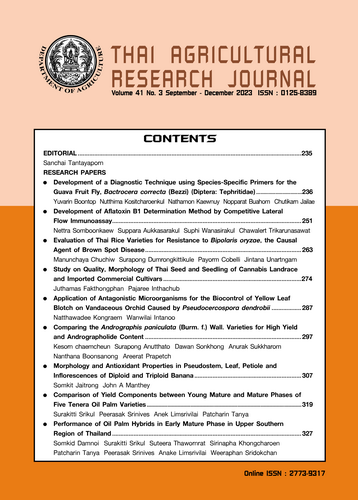Development of a Diagnostic Technique using Species-Specific Primers for the Guava Fruit Fly, Bactrocera correcta (Bezzi) (Diptera: Tephritidae)
DOI:
https://doi.org/10.14456/thaidoa-agres.2023.20Keywords:
Diagnostic, species-specific primers, fruit flies, guava flyAbstract
The guava fruit fly, Bactrocera correcta(Bezzi) causes major economic losses in fruit and vegetable crops in Thailand and many countries. It is also aquarantine pest of countries currently importing the fly’s host commodities from Thailand or are potential new markets. The morphological similarity between immature guava fruit fly and other fruit fly species makes visual identification difficult. Thus, methods for the rapid and accurate identification of immature fruit flies are needed to support quarantine officials at the border stations to make correct decisions when inspecting both importing or exporting commodities. In this study, we used molecular diagnostic methods based on cytochrome c oxidase subunit I (cox1) and species-specific markers to identify B. correcta. DNA barcode sequences obtained from 113 individuals of 11 fruit fly species were used. Based on these 650 bp barcode sequences, we successfully designed species-specific primers for identification of B. correcta in all life stages (egg, larva, pupa and adult).The size of the B. correcta specific fragment was 141 base pairs. The diagnostic protocol based on these primers elicited no cross-reactions with the other 10 tephritid species tested. A PCR product confirmed the specificity of the primers. The species-specific primers have greatly assisted plant quarantine of imported/exported fresh agricultural produce. The diagnostic protocol from this study can be used by pest diagnostic agencies and research organizations worldwide to develop tools for the rapid, accurate identification of invasive alien fruit fly species.
References
ยุวรินทร์ บุญทบ ชมัยพร บัวมาศ เกศสุดา สนศิริ จอมสุรางค์ดวงธิสาร และสิทธิสิโรดม แก้วสวัสดิ์. 2563.การจำแนกชนิดตัวอ่อนแมลงวันผลไม้เผ่า Dacini (Diptera: Tephritidae) ที่มีความสำคัญทางเศรษฐกิจของประเทศไทยด้วยภาพถ่ายจากกล้องจุลทรรศน์อิเล็กตรอนแบบส่องกราด.
วารสารวิชาการเกษตร. 38(3): 293-306.
Aluja, M. and A. Norrbom. 1999. Fruit Flies (Tephritidae): Phylogeny and Evolution of Behavior. CRC Press. 846 p.
Armstrong, K.F., C.M. Cameron and E.R. Frampton. 1997. Fruit fly (Diptera: Tephritidae) species identification: A rapid diagnostic technique for quarantine application. Bulletin of Entomological Research. 87(2): 111–118.
Boontop, Y.2016. Natural variation and biogeography of the melon fruit fly, Zeugodacus cucurbitae (Diptera: Tephritidae), in Southeast-Asia and the West-Pacific. Ph.D. Thesis. Queensland University of Technology, Australia.
Drew, R.A.I. and M.C. Romig. 2013. Tropical Fruit Flies (Tephritidae: Dacinae) of South-East Asia. CABI. London, UK. 664 p.
Drew, R.A.I. and M.C. Romig. 2016. Keys to the Tropical Fruit Flies (Tephritidae: Diptera) of South-East Asia: Indomalaya to North-West Australasia. CABI. Wallingford. 487 p.
Folmer, O., M. Black, W. Hoeh, R. Lutz and R. Vrijenhoek. 1994. DNA primers for amplification of mitochondrial cytochrome c oxidase subunit I from diverse metazoan invertebrates. Molecular Marine Biology and Biotechnology. 3(5): 294-299.
Hall, T. A. 1999. BioEdit: A user-friendly biological sequence alignment editor and analysis program for Windows 95/98/NT. In: Nucleic Acids Symposium Series. 41: 95-98.
Jiang, F., Z.H. Li, Y.L. Deng, J.J. Wu, R.S. Liu and N. Buahom. 2013. Rapid diagnosis of the economically important fruit fly, Bactrocera correcta (Diptera: Tephritidae), based on a species-specific barcoding cytochrome oxidase I marker. Bulletin of Entomological Research. 103(3): 363-371.
Kunprom, C. and P. Pramual. 2016. DNA barcode variability and host plant usage of fruit flies (Diptera: Tephritidae) in Thailand. Genome. 59(10): 792-804.
Life technologies. 2022. Real-time PCR handbook. Availableat:https://www.gene-quantification. de/real-time-pcr-handbook-life-technologies -update-flr.pdf. Accessed: March 9, 2019.
Weems, H.W. and T.R. Fasulo. 2011. Guava Fruit Fly, Bactrocera correcta (Bezzi) (Insecta: Diptera: Tephritidae). University of Florida IFAS Extension, EENY200/IN357.
White, I.M. and M.M. Elson-Harris. 1992. Fruit Flies of Economic Significance: Their Identification and Bionomics. CAB International, UK. 601 p
Downloads
Published
How to Cite
Issue
Section
License
Copyright (c) 2023 Thai Agricultural Research Journal

This work is licensed under a Creative Commons Attribution-NonCommercial-NoDerivatives 4.0 International License.
Thai Agricultural Research Journal



